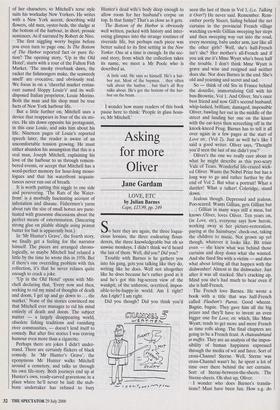Covering the waterfront, without jokes
Mary Wakefield
THE BOTTOM OF THE HARBOR by Joseph Mitchell Jonathan Cape, £12, pp. 295 Critics fell on Joseph Mitchell's last book, Joe Gould's Secret, two pieces origi- nally from the New Yorker, hailing it as a cult classic. After reading The Bottom of the Harbor, another collection from the 1940s to the 1960s, it is not impossible to see why. Joseph Mitchell lived in New York working as a journalist from the age of 21 until his death four years ago, and his passion for the details and routines of the city's water- front life illuminates every sentence.
The obvious comparison is to Flannery O'Connor, who drank in the strangeness of Sixties life in the southern states and poured it out perfectly into oily, mysterious short stories. Unlike O'Connor's, Mitchell's prose is matter-of-fact. But just as O'Connor's eerie, slow descriptions echo the surreality of her characters, so Mitchell's terse style suits his workaday New Yorkers. He writes with a New York accent, describing wild flowers, old men, oyster-beds, the sludge at the bottom of the harbour, in short, prosaic sentences. As if narrated by Robert de Niro.
The first niggling worry begins before you even turn to page one. Is The Bottom of The Harbor reported fact or pure fic- tion? The opening story, 'Up in the Old Hotel', starts with a tour of the Fulton Fish Market. 'The smoky riverbank dawn, the racket the fishmongers make, the seaweedy smell' are evocative, and obviously real. We focus in on a 'cheerful market restau- rant named Sloppy Louie's' and its well- disposed Italian proprietor, Louie Morino. Both the man and his shop must be true facts of New York harbour life.
But a little further on, Mitchell uses a device that reappears in four of the six sto- ries. He sits down opposite his protagonist, in this case Louie, and asks him about his life. Nineteen pages of Louie's reported speech later, the reader is aware of an uncomfortable tension growing. He must either abandon his assumption that this is a real man, Joseph Mitchell, explaining his love of the harbour to us through remem- bered events, or accept that Mitchell has a word-perfect memory for hour-long mono- logues and that his waterfront acquain- tances never run out of breath.
It is worth putting this niggle to one side and persevering. 'The Rats of the Water- front' is a morbidly fascinating account of infestation and disease. Fishermen's yarns about rats the size of small horses are punc- tuated with gruesome discussions about the perfect means of extermination. (Smearing strong glue on pliable shingle using peanut butter for bait is apparently best.) In `Mr Hunter's Grave', the fourth story, we finally get a feeling for the narrator himself. The pieces are arranged chrono- logically, so maybe Mitchell had relaxed a little by the time he wrote this in 1956. But if there's one overriding problem with this collection, it's that he never relaxes quite enough to crack a joke.
`Up in the Old Hotel' opens with Mit- chell declaring that, 'Every now and then, seeking to rid my mind of thoughts of death and doom, I get up and go down to ... the market.' None of the stories convinced me that Mitchell ever manages to rid his mind entirely of death and doom. The subject matter — a largely disappearing world, obsolete fishing traditions and vanishing river communities, — doesn't lend itself to comedy. But after five stories I was craving humour even more than a cigarette.
Perhaps there are jokes I didn't under- stand. There are certainly flickers of black comedy. In `Mr Hunter's Grave', the eponymous Mr Hunter walks Mitchell around a cemetery, and talks us through his own life-story. Both journeys end up at Hunter's own, ready-carved gravestone in a place where he'll never be laid: the stub- born undertaker has refused to bury Hunter's dead wife's body deep enough to allow room for her husband's corpse on top. Is that funny? That's as close as it gets.
The Bottom of the Harbor is obviously well written, packed with history and inter- esting glimpses into the strange routines of riverside life, but perhaps each piece was better suited to its first setting in the New Yorker. One at a time is enough. In the sec- ond story, from which the collection takes its name, we meet a Mr Poole who is described as,
A little odd. He says so himself. He's a har- bor nut. Most of the baymen... they often talk about the harbor... but that's all Roy talks about. He's got the bottom of the har- bor on the brain.
I wonder how many readers of this book pause here to think: 'People in glass hous- es, Mr Mitchell.'



























































 Previous page
Previous page